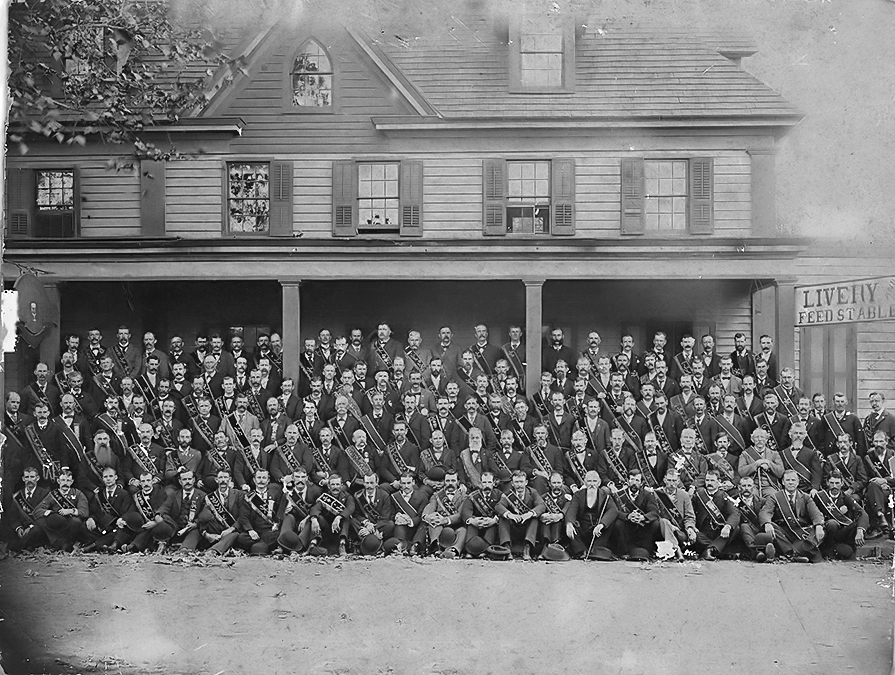
The building in front of which a good-sized group of sash-wearing gentlemen posed is the Hotel Jester, on Federal Street, on the present-day site of the Goshen Methodist Church. It was formerly the Hart House until it was sold to James J. Jester in 1908. Peter J. Hart (1839 – 1934) built the Hart House sometime after 1880, ran it until 1885, then took over management of the Brick House in Georgetown until 1889. He then returned to Milton and resumed proprietorship of Hart House. The chain of ownership between 1889 and 1908 is confusing; there were several different owners, among them Hickman in 1888, Lightcap in 1897, Luke Clendaniel in 1898, and Elihu Lynch in 1900. The last owner, Louisa Russell, sold the Hart House back to Peter Hart in 1904.
The state legislature’s approval of the Local Option in 1907, giving each of Delaware’s three counties and Wilmington the right to decide whether to go “dry” or remain “wet,” put a crimp in the revenues of Milton’s hoteliers, as the sale of beer and spirits in hotel bars was a real moneymaker; this may have been a factor in Hart’s sale to James J. Jester in 1908. He and his wife Lydia ran the hotel for nearly twenty years until her death and his failing health resulted in the sale of the hotel to Mr. and Mrs. James Derrickson Cropper of Robbins, in 1929. From the short classified ad in the Wilmington Morning News of March 16, 1929, we can get an idea of what the Hart House interior was like:

Census records show the Croppers living in Salisbury, MD in 1930, which begs the question: did they still own the hotel, or did they turn around and sell shortly after they bought it?

One element in this photograph casts doubt on the ownership at the time the group sat for this portrait. At far left, just below the midpoint of the vertical, there is a sign with a beer glass and faint lettering next to it which I think is the word BEER. Since Sussex County and Milton went “dry” in 1907, I am inclined to think that this is a photograph of the hotel when it was Hart House rather than Hotel Jester.
The group of 145 gentlemen (if I counted correctly) are members of the Improved Order of Red Men. As far as I can tell, all of them are wearing sashes of a fraternal order that was not identified in the labeling of the photograph, but upon zooming in, a symbol becomes clearly visible (see below):

The crossed sword, tomahawk and musket were the symbol of the Red Men organization. According to the relevant Wikipedia article, the Improved Order of Red Men chartered by Congress in 1834 is the oldest patriotic fraternal organization in the U. S. The organization’s web site, redmen.org, describes its mission as follows:
We are a non-profit organization devoted to inspiring a greater love for the United States of America and the principles of American liberty. Along with our women’s auxiliary, the Degree of Pocahontas, we support various charitable, youth, and educational programs.
The Improved Order of Red Men claim direct descent from the “Sons of Liberty” of Boston Tea Party fame, who dressed as Native Americans when they dumped tea on a British cargo ship into Boston Harbor. There is blatant “cultural appropriation” here, as least to our contemporary sensibilities, but nobody in the 19th century (except perhaps Native Americans) would have had an issue with white men performing rituals and using language that they attributed to Native Americans. Language in the organization’s constitution of 1886 is a prime example of the paradox of cultural appropriation side-by-side with exclusionary practices:
No person shall be entitled to adoption into the Order except a free white male of good moral character and standing, of the full age of twenty-one great suns, who believes in the existence of a Great Spirit, the Creator and Preserver of the Universe, and is possessed of some known reputable means of support.
The organization claimed half a million members in 1935, but that has declined to less than 15,000 today. At the time the group photo was taken, the order provided its membership with disability insurance of $3 per week for six months and $2 per week thereafter, plus a death benefit of $100, for 12 cents a week in dues. Milton’s chapter was the Chippewa tribe (No. 28); all other chapters bore Native American tribal names.
It is unclear whether the group portrait is exclusively that of the members of the Milton chapter, or included guests from other “tribes.” The large number of men suggests the latter of the two possibilities, and Milton lodges of all fraternal organizations hosted brethren from other lodges regularly.

